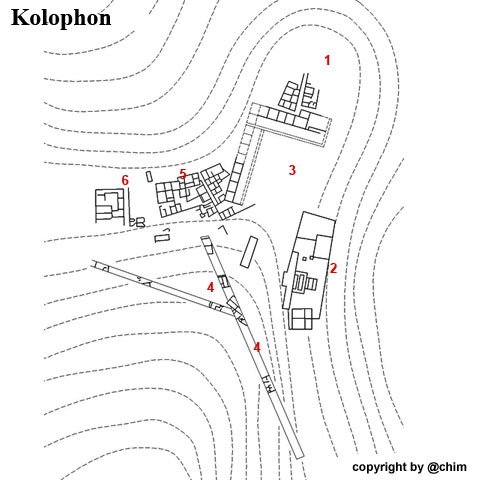 |
| Kolophon in Ionia | |||||
|
|
| ||||
|
It is hard to imagine today because of the few remains, but the city of Kolophon was considered one of the richest cities in Ionia in archaic times, but lost much of its prosperity in classical times. |
|||||
|
|
|||||
|
As one of the mother cities of the Ionians, colophon was part of the Ionian League. The conifers around rosin provided the resin rosin, which is now used, among other things, to rub the horsehair covering of bows. |
|||||
|
|
|||||
|
According to legend, the city was founded by two sons of Kodro, a mythical king of Athens. Her most famous sons are the philosopher Xenophanes, the poet Mimnermos and the painter Apelles. Colophon was also one of the Ionic cities competing to be Homer's birthplace. |
|||||
|
|
|||||
|
After 479 B.C., the city became a member of the Attic sea union; in 430 B.C., after party struggles, it became Persian and rejoined Athens in 409. In 404 B.C., colophon fell again under Persian sovereignty, only to share the general fate of Ionia in the 4th century B.C.. Lysimachos, one of Alexander the Great's Diadoches, forced the population to relocate to Ephesus around 300 B.C., which was built under his command in a new location. Thus the city of Kolophon lost its importance, even though it was rebuilt after Lysimachos' death in 281 BC. Colophon merged with the port city of Notion, but lost all meaning in Hellenistic times. |
|||||
|
|
|||||
|
|
|||||
|
|
|||||
|
Kolophon was located at today's village Degirmendere between Izmir, the ancient Smyrna (in the north) and Ephesos (in the south), 13 km north of the port city Notion. |
|||||
|
|
|||||
|
|
|||||
|
|
|||||
|
Site plan of the ancient city of Kolophon after excavations 1922 - 1925 |
|||||
|
|
|||||
|
|
1 Acropolis | 4 Exploratory ditches | |||
|
|
2 Metroon (Temple of Kybele) | 5 Palace complex | |||
|
|
3 Agora | 6 Bath | |||
|
A Mycenaean dome tomb from the 13th or 12th century BC was discovered in the vicinity, apparently also containing sub-Mycenaean pottery. In another tomb a Mycenaean knife and a glass bead of Aegean style came to light. |
|||||
| Photos: @chim, Jürgen P. | |||||
| Translation aid: www.DeepL.com/Translator | |||||
| Source: Wikipedia u.a. | |||||
|
|
|||||


